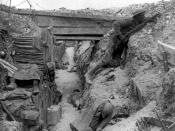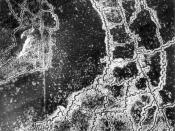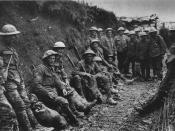WORLD WAR 1 COURSEWORK
Question 1: Describe the conditions that soldiers experienced on the Western Front in the years 1915-1917.
From 1915 to 1917, the First World War was fought in trenches. The trench systems built along the Western Front were very complicated. Both sides dug a line from the English Channel to the Swiss border, to protect their armies during the winter. The British front-line trenches were between two and three metres deep and 1.5 metres wide. Either wood or corrugated iron strengthened the sides. Huge rolls of barbed wire up to 30 metres wide protected them. Behind the front-line trenches were support trenches and communication trenches, along which supplies and troops were moved. The stores and kitchens could be found in the support trenches, as could latrines. Dugouts were where the soldiers rested, and were underground shelters in the sides of trenches where soldiers were given a plank to sleep on.
Ammunition stores, field hospitals and artillery posts were further back, behind the system of trenches. The area between the two lines of trenches was 'no man's land' and was up to 500 metres wide.
Most of the area that the British troops were forced to dig trenches in was usually very close to sea level, therefore along the whole line the soldiers had to struggle with water and mud. Duckboards (planks of wood) were placed at the bottom of the trenches to try and keep the trenches as dry as possible. Much of the land was also clay therefore the water could not drain away so when it rained the trenches became waterlogged. The craters in the ground in no man's land made from the shells from guns and bombs also filled with water which then poured into the trenches.
The men standing for hours on end...


